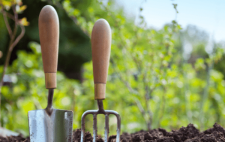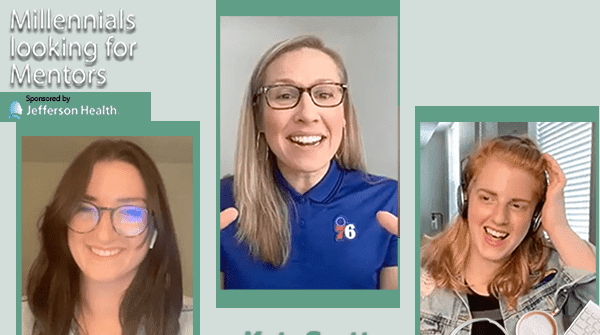Whether you’re a beginner gardener or a green thumb-ed expert, it’s never too late – or too early – to add sustainable practices to your garden. We stole some time with SJ Mag Media’s resident gardener, Toni Farmer, while filming the new season of “The Goal is to Become a Gardener,” to ask her for a few eco-friendly tips and tricks.
Grab your gloves, it’s going to get a little messy!
Plant power
Have you ever heard of a super plant? Ok, we kind of made that phrase up, but hear us out, it makes complete sense. “Plants adapt to their ecosystems,” Farmer says. “Some adapt quickly and some adapt over a very long period of time.”
Basically, when you save your seeds from year to year, their genetic material gets used to the environment and can grow well in it. And that means you can put in a little less effort to get them to grow – and use less resources, which is always a good sustainable gardening practice. It’s also going to save you money at the garden center as seed prices continue to rise.
But make sure when you save your seeds, you save the right ones. “It’s called selective breeding,” Farmer says. “Don’t save the seeds from that dinky little zinnia flower that barely made it. Save them from the spectacular zinnia and the giant, gorgeous tomato. The most beautiful of whatever it was that you grew.”
And if one type of plant had a harsh season all around and none of them grew to be quite so impressive, Farmer says you don’t have to get rid of all of them. Things happen. There are horrible droughts, seeds aren’t cared for properly, so she recommends using your own judgment.
Another way to fortify your crops is by choosing plants that are native to where you live – called native plants if it wasn’t obvious. Think of it this way, if your special tomato plant that you’ve saved year after year gets some “super powers” after 5 years, imagine what would happen if you did it for thousands of years.
That’s what has happened with native plants. They’ve evolved over the centuries and feel right at home in their native habitat. It also helps that these special plants have evolved alongside native pollinators. Just think of them as Batman and Robin.
“I always use monarch butterflies as an example,” Farmer says. “They really cannot survive without milkweed. They’re partners, and every pollinator has a partner or two. So you should be focusing on buying plants native to New Jersey, and then you’re keeping all those pollinators that love that food source really happy and coming back to your garden.”
Need a few New Jersey native plants to add to your garden? Try violets, blueberries, dogwoods, milkweeds (bring on the monarchs!), sunflowers and nodding onion.
It’s pronounced wooder
As climate change continues to affect our seasons, gardeners should prepare for more droughts and sporadic rain, says Farmer. While that means we could get spans of heavy rain – in the first week of April, some areas got 5 or 6 more inches of rain than normal, according to the Weather Channel – it can also mean going several weeks in the summer without significant rainfall.
“Someone recently said to me, ‘I don’t want to hear about not having enough water this summer,’” Farmer says. “Well, it’s not gonna last.”
While some of this rain will become groundwater and help our soil, Farmer recommends taking measures to prevent your plants from suffering during stretches of heat expected this summer.
Farmer’s go-to water saver is using mulch and cardboard with certain plants. The combo is a must for keeping water trapped in your soil, so that in the middle of the summer, deep in a heatwave, you can pull back the mulch and cardboard and find wet soil underneath.
All you have to do is put down cardboard on top of your soil, then spend a minute soaking it so you can cut a hole in the middle for your seed. Finally, top the cardboard with mulch. And voila, you have water protection.
Another way to keep your soil soaked through the season is by installing a drip hose – a hose with holes through it that you bury under your soil to water from underneath instead of soaking from the top. You might also see it called a soaking hose.
“You’ll actually spend less time and money watering,” Farmer says. “It’s going right into the soil, it’s not evaporating. And it’s not helping spread disease that can be spread with water on the leaves of the plant.”
You can also help conserve water with biostimulants. It’s an easy way to help your plants soak up the water, and there are a number of brands to choose from. “You really only need to treat your garden once or twice for the whole season,” Farmer says.
Farmer also recommends taking advantage of any storms by investing in a rain barrel. Keep the barrel on the side of your house to collect water when it rains, and you’ll have some extra supply this summer.
Compost isn’t gross (ok, maybe a little)
The same way we need hearty meals to grow strong, our plants need nutrient-rich and healthy soil to grow strong and beautiful – and delicious. And a sustainable way to help our plants get the nutrients they need is by making your own compost, says Farmer.
“Compost is organic matter of everything that’s broken down in your backyard: leaves, twigs, dead animals, maybe a little animal manure,” she says. “And it breaks down into a hummus-like mixture that will add a little bit of nutrients to the garden and add massively to the soil structure, soil health and the microbiome that’s so important.”
Compost is mixed into the top 12 inches of your garden bed. “It will soak up and hold water, and slowly release water and nutrients during the year,” says Farmer.
But heads up, it’s a year-long process.
You can start by buying a compost tumbler, building a DIY box or just picking a spot in your backyard to lay your compost. It’s up to you.
No matter how your compost is stored, however, it has to have 2 things: brown and green ingredients. “You want about ¾ of your pile to be brown – the dead ingredients like leaves, sticks, anything that’s turned brown,” Farmer says. “The other ¼ of the pile should be green, the wet ingredients. That’s anything still vibrant and green plus our food waste.”
And speaking of food waste, Farmer suggests buying a small compost bucket to keep in your kitchen. We promise, it won’t smell – as long as you empty it regularly. When it’s ready to be emptied, go outside and dump it on your compost pile, cover it with about 6 inches of leaves and leave it (pun intended).
After you’ve had your pile for a year, it’s time to flip it. Literally, turn the compost over. Then, start a new pile. And easy as that, you’re on your way to healthy soil.


Check out all 4 seasons of “The Goal is to Become a Gardener” with Toni Farmer & Marianne Aleardi – see how to compost, plant seeds, lay a soaker hose…everything you need to get gardening! And look for the start of Season 5 on SJ Mag Media’s Facebook page on May 16!












